UPDATE June 10, 2009: Revised edition EZ AA added to the review
In my original testing of the EZ AA, I noticed reduced output and low runtime efficiency of the EZ AA Lo mode. NiteCore promptly issued a recall in early April 2009, and worked to revise the product. They have sent me a revised shipping version, which is now added to this review. I have left the background pics the same, as the light does not look appreciably different. Where appropriate, I have updated this review with the new info.
---------------
Reviewer's Note: The NiteCore EZ AA was provided by NiteCore for review.
Warning: Pic heavy!
The EZ AA is the latest much-anticipated 1xAA offering from NiteCore. Unlike the continuously-variable NiteCore models, this light is a simple two-stage twist interface similar to a number of keychain lights (e.g JetBeam Jet-μ, Aeon, etc.). In fact, the EZ AA appears to be designed to compete with 1xAAA keychain lights, given its remarkably small size for a 1xAA light.
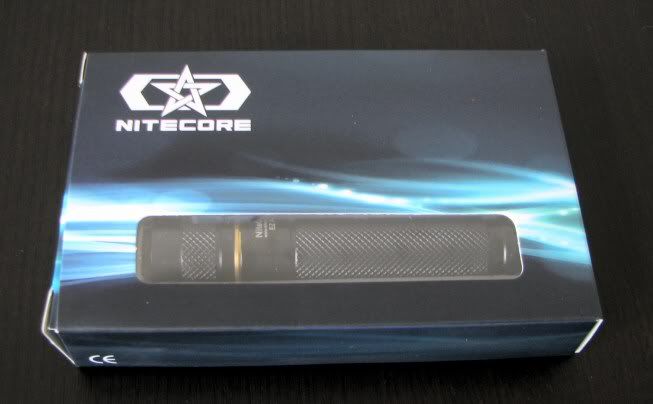
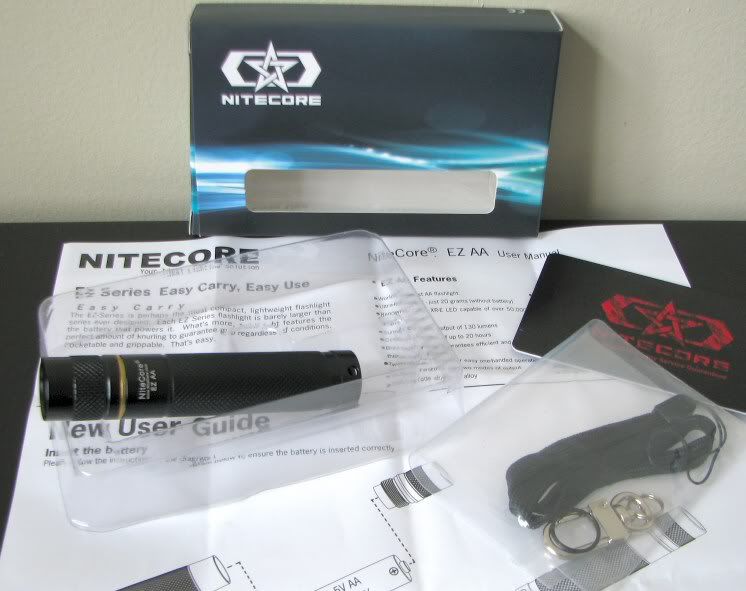
Packaging is similar to the D10/EX10 series NiteCore lights, and comes with a one-page instruction sheet, warranty card, wrist lanyard, extra o-rings, and new "lock-style" keychain clip. No holster or body tube clip is included (or available, AFAIK).
UPDATE: The instruction sheet has been updated with new output and runtime specs, and now explicitly supports Li-ion (i.e. 14500). Here is a summary of the changes.
Original EZ AA Instructions:
Since I know size is the prime concern for a keychain light, I thought I would show you how it compares to a couple of 1xAAA and 1xAA lights.
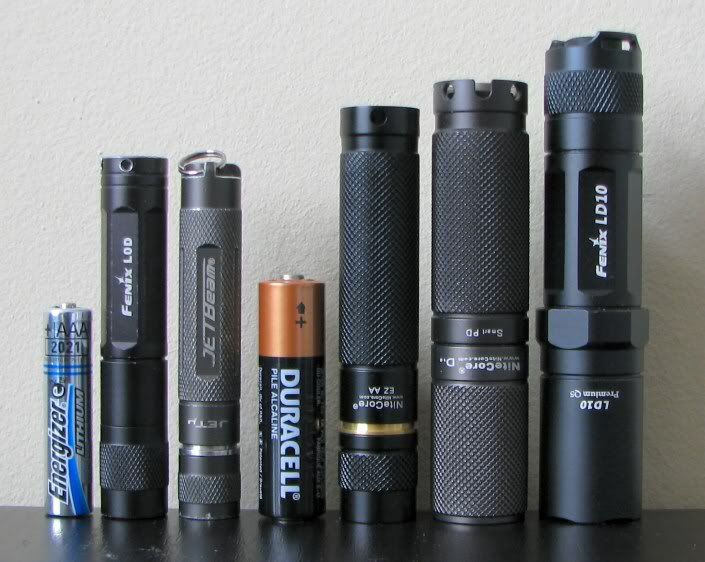
EZ AA: 85.0mm x 16.6mm, 20.9g (no battery)
The EZ AA is certainly among the smallest 1xAA lights I've seen (although the award for that goes to the Zebralight H50 headlamp). Build design is somewhat similar to my 1xAAA JetBeam Jet-μ, but on a larger scale to accommodate the 1xAA cell.
Note that the 85.0mm height is with a battery installed but not activated. In comparison, fully engaged at max output would be ~83mm, but I doubt you'd be carrying it that way on your keychain.
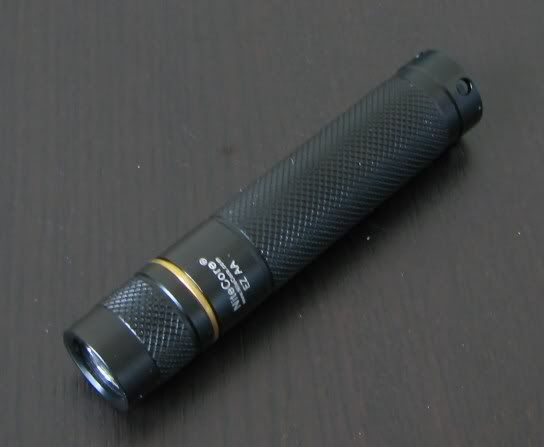
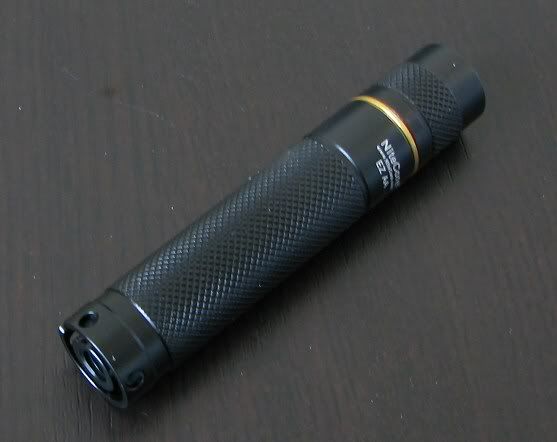
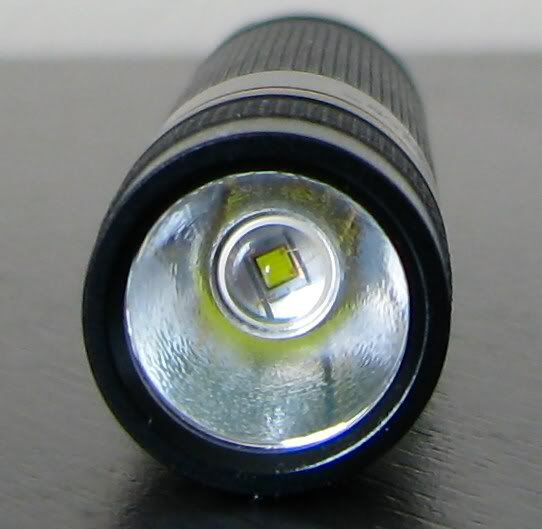
Overall and fit and finish are excellent on my sample. Emitter is well focused in the reflector and gives a nice beam (scroll down for beam shots).
So what's under the hood? :naughty:
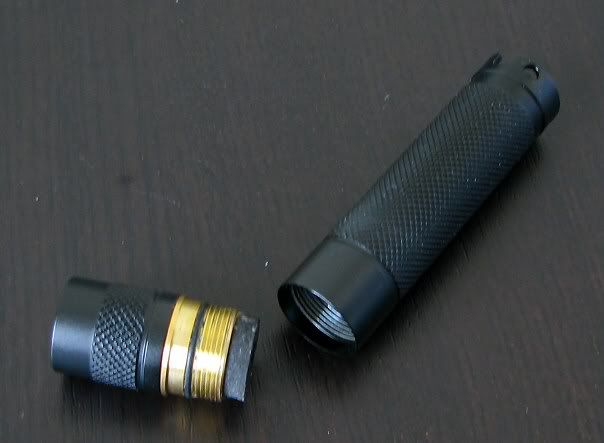

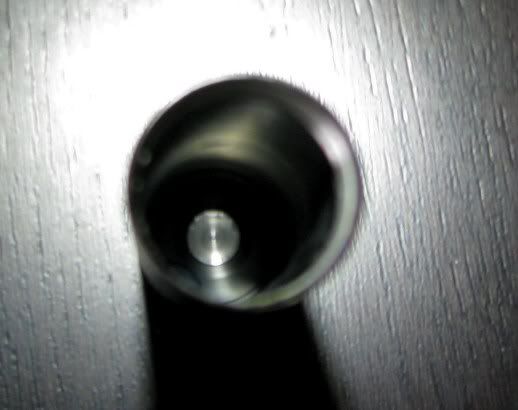
As you can see, the head of the EZ AA has a brass pill, instead of the typical aluminum. This is presumably for heat-sinking purposes - although aluminum has better thermal conductivity than brass, brass is considerably denser than aluminum. Normally it wouldn't be an issue, but given the low overall mass of the light, my guess is that they wanted to beef up the heat-sinking ability without raising the overall size and weight (not sure if it makes much of a difference though - scroll down this thread for a discussion). :candle:
The head contact surface includes a small spring surrounded by a foam cushion. On twisty lights that require tightening for activation, the foam is typically used to reduce battery rattle (and potentially to limit contact surfaces for multi-stage lights). The head spring is a good idea, given the lack of a spring in the tail region (note the small metal post at the base of the battery tube in the pic above). These type of lights run the risk of crushing your cells if there isn't some sort of variable-resistance spring included somewhere.
User interface is very straight-forward: tighten the head until the light comes on (Lo mode). Keep tightening until full contact is made and the light switches to Hi. In my testing, it typically took about one-and-a-quarter full turns past the Lo activation point to reach Hi. To turn off, loosen the head until the light turns off. :kiss:
UPDATE: The revised EZ AA requires a shorter twist to activate Hi from Lo - a little over three-quarters of full turn now, instead of a one-and-a-quarter turn.
Note: Do NOT keep tightening past the point Hi comes on, or you risk damaging your cells.
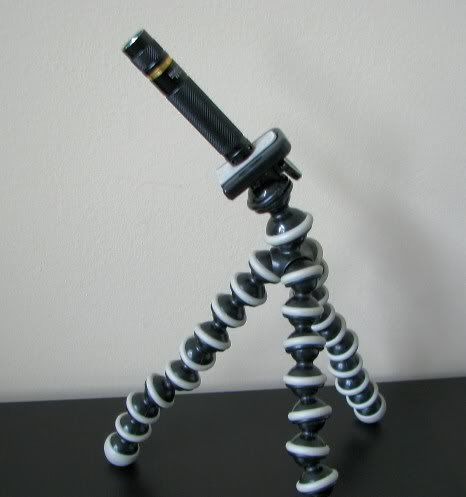
The light comes with a standard quarter-inch tripod attachment point in the base. Note that in the pic above I am using a larger model "gorilla" flexible tripod than the one most places sell.
Comparison Beamshots
Given the interest in the output of both the Hi and Lo modes, I've done some comparison beamshots at both settings. Comparators used are the NiteCore D10 (Cree Q5) and Fenix LD10.
All lights are on 100% on Sanyo Eneloop. Distance is about 0.5 meters from a white wall.
Hi mode :
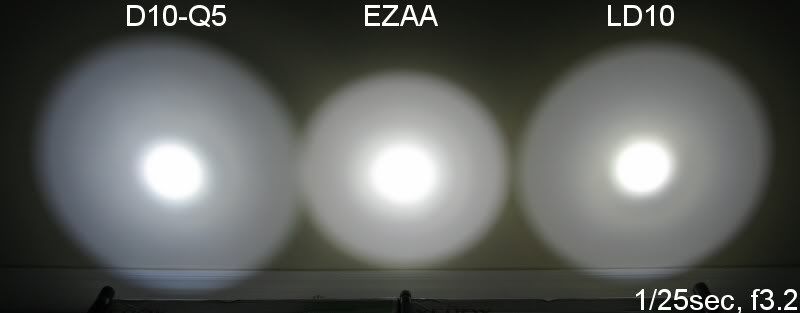

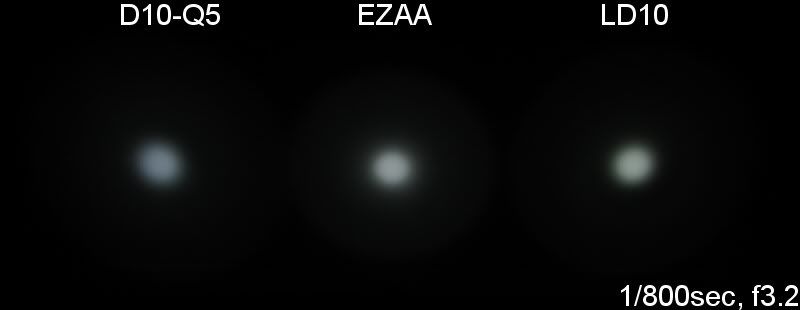
Spillbeam width is slightly less than the NiteCore D10 or Fenix LD10, likely due to the narrower head/reflector. Note the relative absence of Cree rings despite the good amount of centre-beam throw. Max output is certainly in the same ballpark as the others (see Summary Table later in this review for a comparison).
UPDATE: The Hi mode appears to be unaltered on the revised version, so I've let these original pics stand. Here is a direct comparison of the new revised EZ AA to the original:
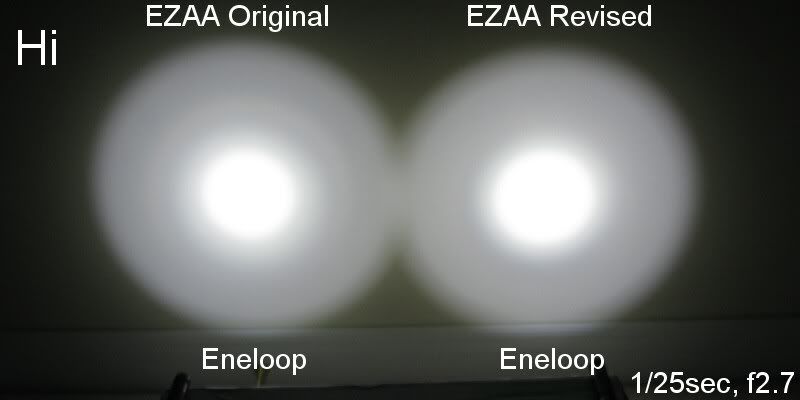
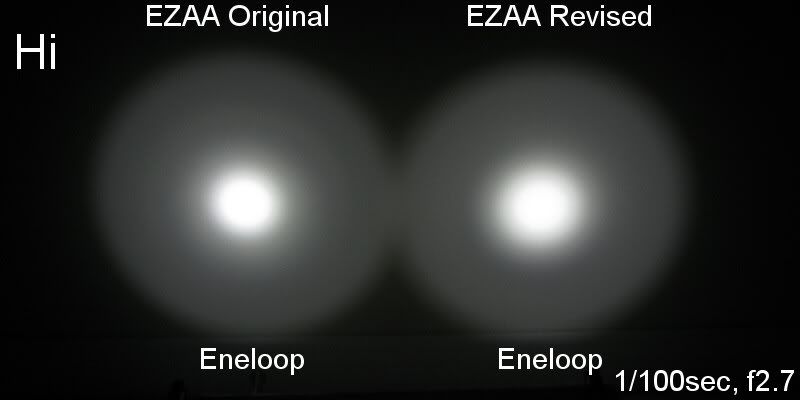
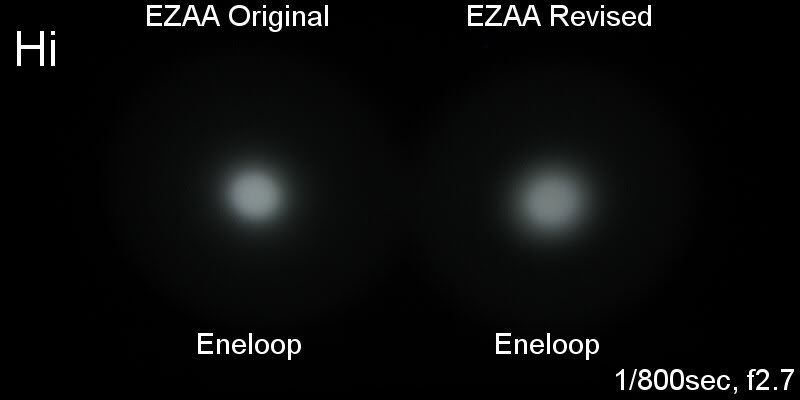
As you can see, my revised sample is slightly less focused for throw, but is otherwise comparable.
Lo mode:
UPDATE: The original EZ AA had abnormally low output, so I have replaced the beamshots here with a direct comparison of the original EZ AA to the new revised version:
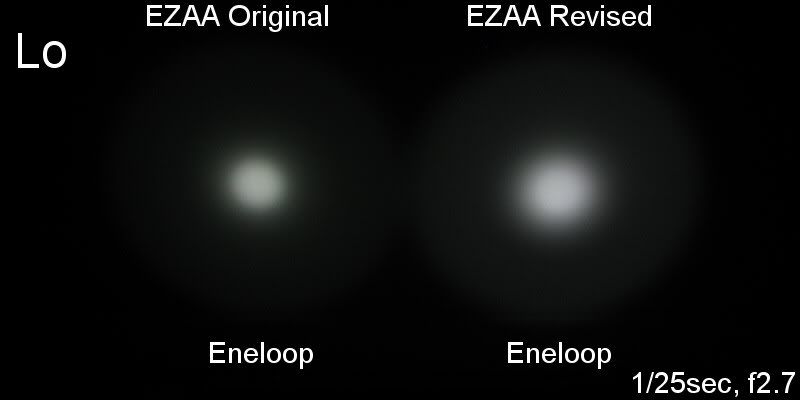

As you can see, the new EZ AA is detectably brighter on its Lo setting. Scroll down to the summary table and runtimes for more details.
Testing Method: All my output numbers are relative for my home-made light box setup, a la Quickbeam's flashlightreviews.com method. You can directly compare all my relative output values from different reviews - i.e. an output value of "10" in one graph is the same as "10" in another. All runtimes are done under a cooling fan.
Throw values are the square-root of lux measurements taken at 1 meter from the lens, using a light meter.
Throw/Output Summary Chart:
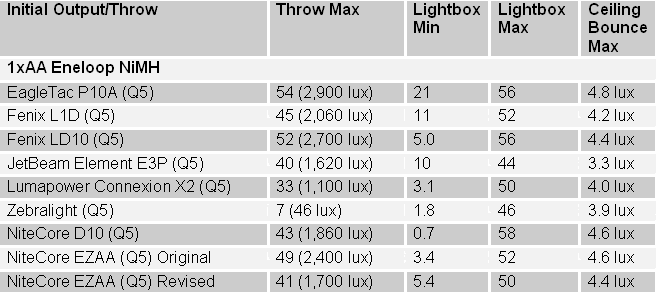
The throw of the EZAA remains about typical for a 1xAA light of this brightness. Max output on NiMH is also about a typical for a well-driven light, in the same league as the D10 or Fenix LD10.
UPDATE: The original EZ AA had an abnormally low Lo mode, likely somewhere around 6-7 lumens based on my comparisons to other lights of known lumen estimate (a far cry from the original 15 lumen specs). This new revised EZ AA seems pretty much bang on with the revised specs of 10 lumens. The new EZ AA now also supports 14500 Li-ion, as shown below:
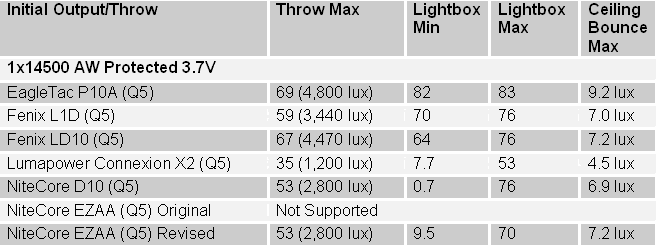
Definitely a bit brighter on Li-ion than standard batteries, so I don't recommend you run it on Hi for extended periods without cooling. Note also that it was rather difficult to activate Hi on protected 14500 on my sample without using a LOT of twisting force.
Here are some additional beamshots comparing Hi and Lo on 14500 vs Eneloop:
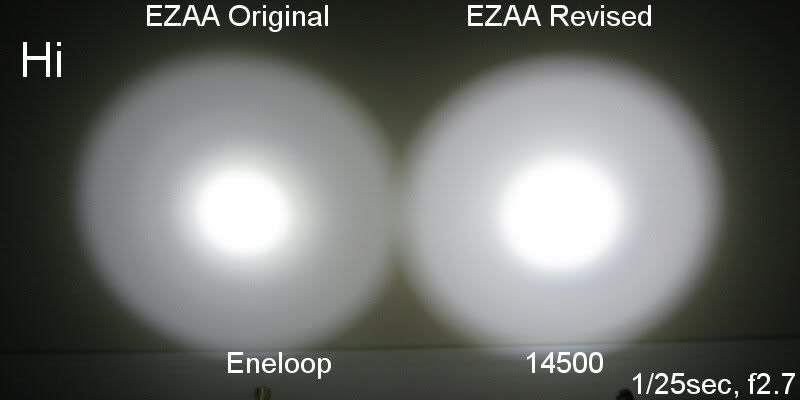
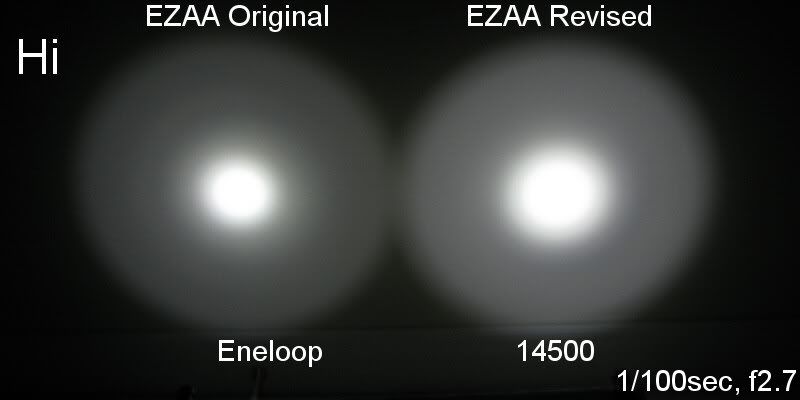
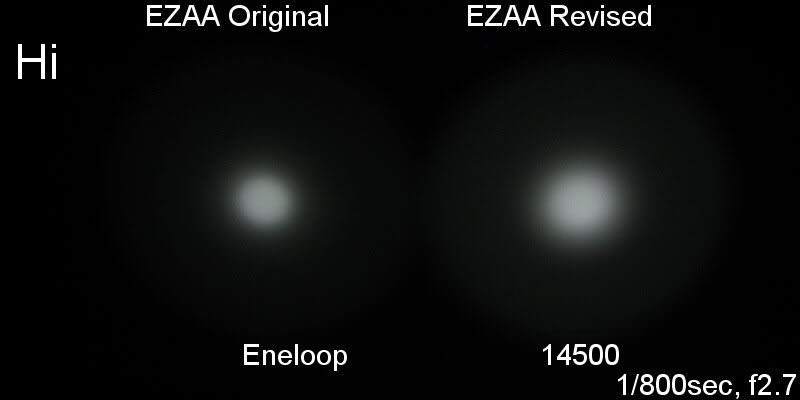
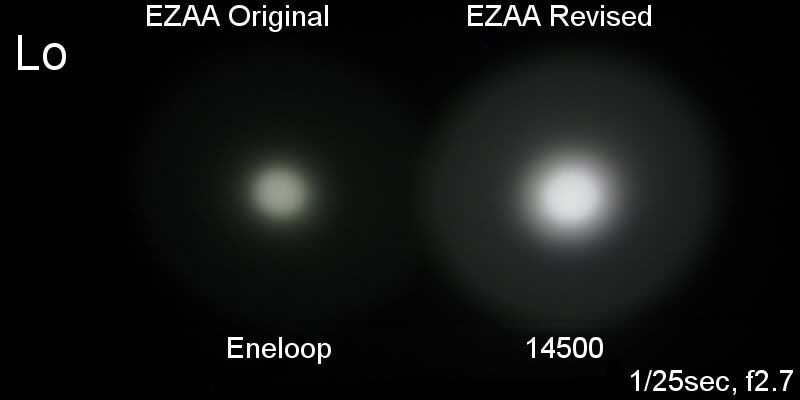
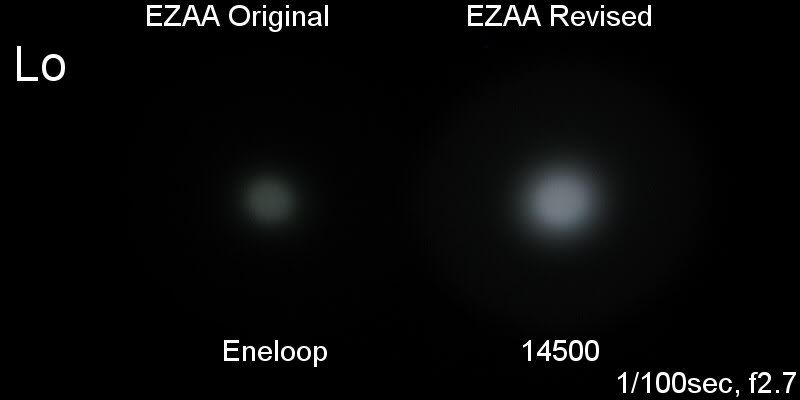
Output/Runtime Comparison
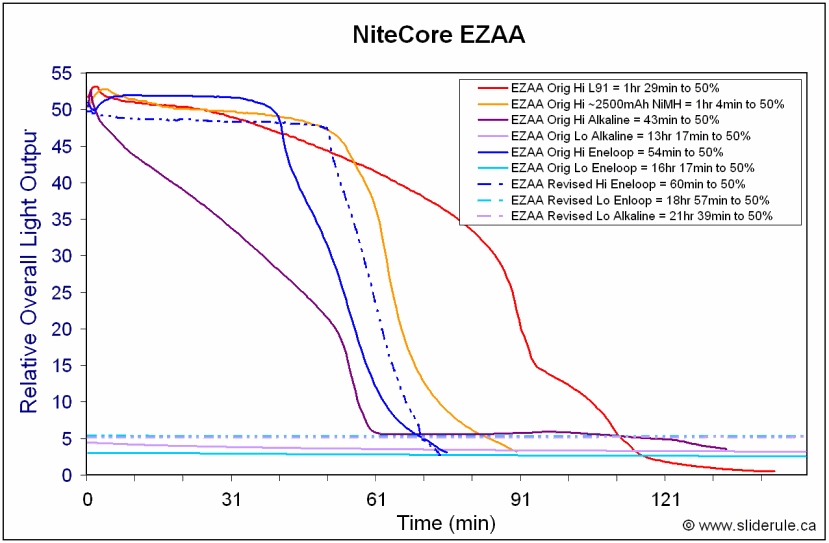
UPDATE: I have only done Eneloop runs so far, but as you can see above (dotted lines) performance on Hi is not that different from before - although regulation seems to be enhanced. Output and runtime on Lo is considerably enhanced - scroll down for a better illustration. I will continue to update these graphs as the rest of the battery types are tested. Note again that 14500 is now supported on the new EZ AA.
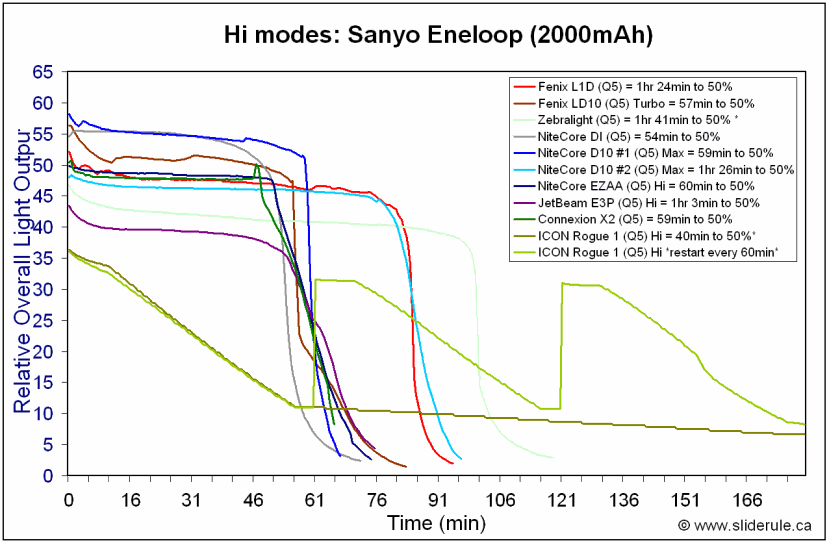
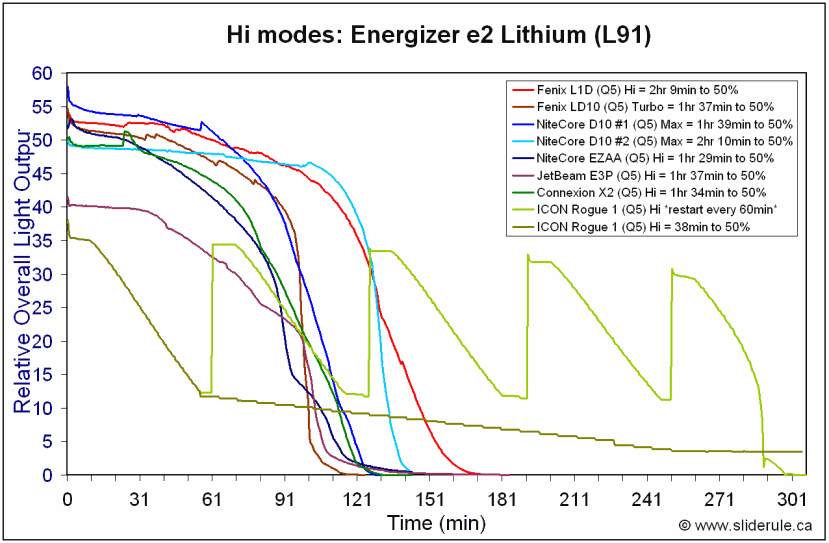
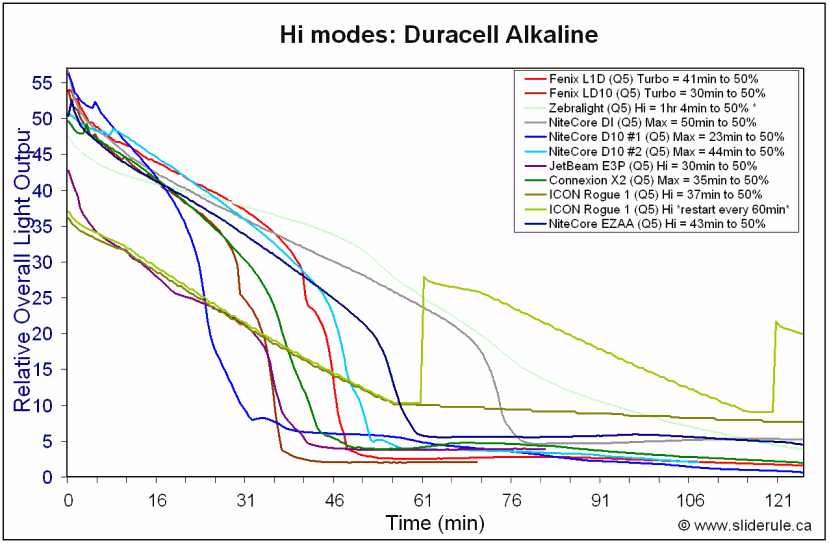
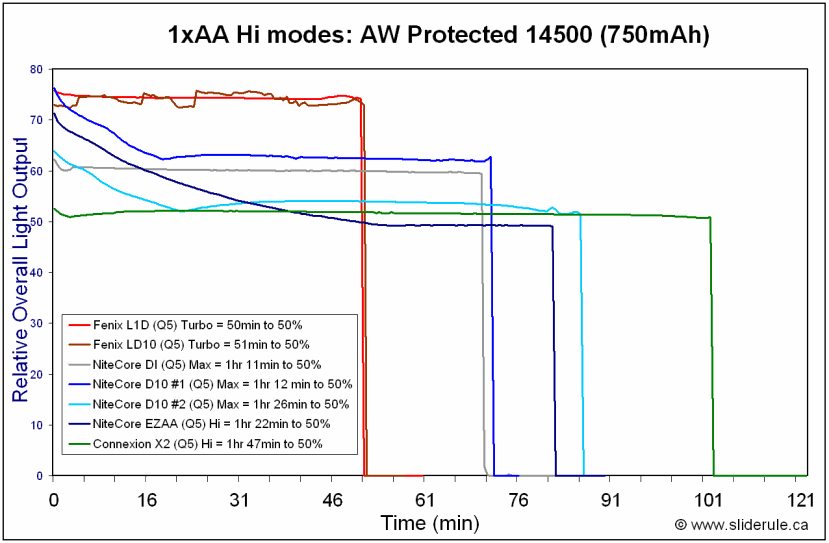
Output/runtime efficiency is certainly acceptable on Hi (actually looks a lot like the Eagletac P10A). But good performance here is not that surprising - there is not really a lot of difference between various 1xAA models when driven maximally.
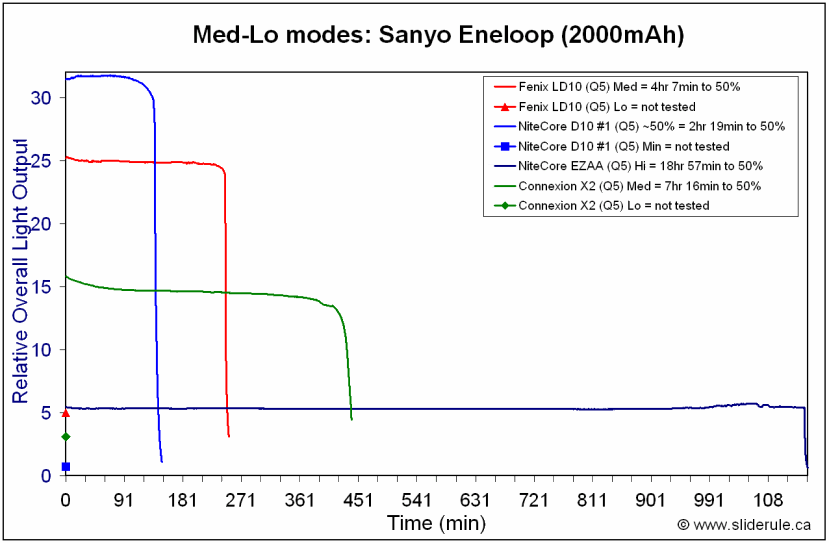
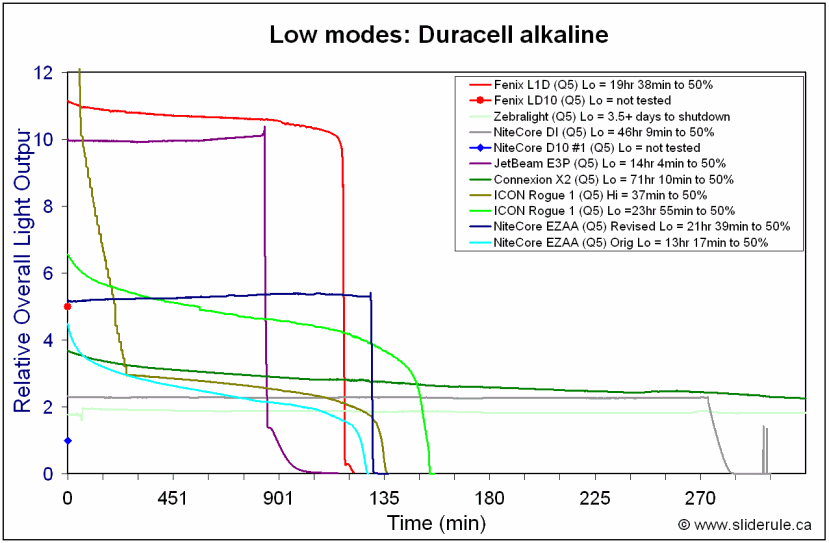
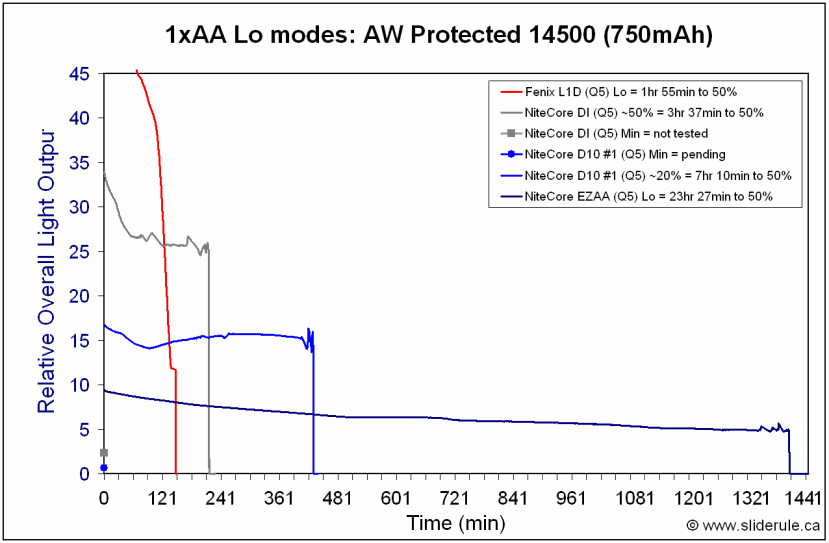
UPDATE: The performance on Lo on alkaline has drastically improved on this revised version. Note the full regulation pattern now, and the more than double output/runtime efficiency. Also notice the particular good Lo runtime on 14500.
Potential Issues
Although impressively small for a 1xAA light, I am not sure if everyone would find it feasible on a keychain (it might be most suitable for those who carry their keys in a purse or in baggy pant pockets). For short periods of time, I have tried carrying it in my jeans front pocket on my keychain instead of my 1xAAA Jet-µ, and honestly I haven't noticed the difference (but I also have a fair number of keys on there, so my keychain is bulky to start). This is likely to be highly subjective and variable among users, so YMMV.
Tighten-to-activate twisty lights always have the potential to be battery crushers, so care needs to be used not to over-tighten. Inclusion of the head spring is a good idea, but common sense should still prevail.
Preliminary Observations
The EZ AA certainly lives up to its name - it's an easy to use light. Basically, you could treat it as a single-stage low light, like the Fenix E01 - simply twist to activate. But you also have the option to fully tighten to jump to the max possible output you could reasonably expect on a 1xAA light (on standard batteries).
What is really different about this light is its slim lined design - they have kept it as thin as possible to allow you to potentially run it on a keychain. The limited storage capacity of a 1xAAA battery (which is the usual dominion of keychain lights) can be frustrating, so I can see the appeal of this design. But I'm not sure yet it if it will be comfortable enough for EDC keychain pocket carry over the long-term - in short testing so far, I honestly haven't noticed the difference compared to my Jet-µ :shrug: I will report back on my extended experience with it once all the runtime testing is complete.
Consistent with NiteCore offerings, the light appears to be of high quality, with careful attention to detail in the design (e,g. small spring on the head, brass heatsink, etc.). Despite the small size, the reflector does a very good job in balancing decent throw with a very smooth beam (especially for a Cree). And despite the thin battery tube walls, the light still feels solid to me. I would think many would find this an attractive package even if they weren't looking for the thinnest possible 1xAA. :twothumbs
As with all lights, it comes down to what your intended use is. Even if keychain carry isn't a priority for you, you might prefer the KISS interface and slim-lined design of the EZ AA. But if you are looking for a good all-around general purpose light, I think you would want to carefully consider the NiteCore D10. For a little more money, you get a slightly larger light with much greater versatility (i.e. lower Lo, continuously variable interface, choice of twisty or piston-clicky action, etc.).
But if you are looking for a good all-around general purpose light, I think you would want to carefully consider the NiteCore D10. For a little more money, you get a slightly larger light with much greater versatility (i.e. lower Lo, continuously variable interface, choice of twisty or piston-clicky action, etc.).
For a simple two-stage light intended for EDC use, I personally like the choice of output levels on the EZ AA. The Lo mode is lower than I expected, and the option for max power is appreciated. I think these are sensible output choices for the intended usage, but given the lower body mass I don't recommend you run it on Hi for extended periods of time without some form of cooling (i.e at least hand-hold it).
UPDATE: The revised EZ AA has considerably improved output/runtime efficiency on Lo - more than double that of the original EZ AA overall. :thumbsup: And the performance on 14500 is very impressive. oo:
oo:
Lo output is now a believable 10 lumens on standard batteries. Some may still find this too low for a two-stage light, but I rather like it for keychain carry. For those that want more, Lo output on 14500 is measurably higher for most the time (i.e. 15+ lumens).
The reduced amount of twisting necessary to access Hi from Lo is useful on the new EZ AA. Also, 14500 Li-ion support is a nice addition, as it gives users more options (although again, I wouldn't recommend running it for extended periods on Hi).
All in all, a good upgrade from the original version.
In my original testing of the EZ AA, I noticed reduced output and low runtime efficiency of the EZ AA Lo mode. NiteCore promptly issued a recall in early April 2009, and worked to revise the product. They have sent me a revised shipping version, which is now added to this review. I have left the background pics the same, as the light does not look appreciably different. Where appropriate, I have updated this review with the new info.
---------------
Reviewer's Note: The NiteCore EZ AA was provided by NiteCore for review.
Warning: Pic heavy!
The EZ AA is the latest much-anticipated 1xAA offering from NiteCore. Unlike the continuously-variable NiteCore models, this light is a simple two-stage twist interface similar to a number of keychain lights (e.g JetBeam Jet-μ, Aeon, etc.). In fact, the EZ AA appears to be designed to compete with 1xAAA keychain lights, given its remarkably small size for a 1xAA light.


Packaging is similar to the D10/EX10 series NiteCore lights, and comes with a one-page instruction sheet, warranty card, wrist lanyard, extra o-rings, and new "lock-style" keychain clip. No holster or body tube clip is included (or available, AFAIK).
UPDATE: The instruction sheet has been updated with new output and runtime specs, and now explicitly supports Li-ion (i.e. 14500). Here is a summary of the changes.
Original EZ AA Instructions:
- Battery illustrated as "1.5V AA" only
- Warning included: "do not use batteries that exceed 2 volts, as they may permanently damage the flashlight."
- Hi mode listed as "130 lumens for 1.5 hrs"
- Lo mode listed "15 lumens for up to 20 hours"
- Battery illustrated as simply "AA" with voltage restriction
- Previous warning against >2V replaced with: "DO NOT use rechargeable Li-ion batteries without safety circuit." (suggesting that protected 14500 IS supported).
- Hi mode is now listed as "130 lumens for up to 50 minutes" (which seems more consistent with my runtime results)
- Lo mode is now listed as "10 lumens for up to 20 hours" (which seems more consistent with my output readings and runtimes)
Since I know size is the prime concern for a keychain light, I thought I would show you how it compares to a couple of 1xAAA and 1xAA lights.

EZ AA: 85.0mm x 16.6mm, 20.9g (no battery)
The EZ AA is certainly among the smallest 1xAA lights I've seen (although the award for that goes to the Zebralight H50 headlamp). Build design is somewhat similar to my 1xAAA JetBeam Jet-μ, but on a larger scale to accommodate the 1xAA cell.
Note that the 85.0mm height is with a battery installed but not activated. In comparison, fully engaged at max output would be ~83mm, but I doubt you'd be carrying it that way on your keychain.



Overall and fit and finish are excellent on my sample. Emitter is well focused in the reflector and gives a nice beam (scroll down for beam shots).
So what's under the hood? :naughty:



As you can see, the head of the EZ AA has a brass pill, instead of the typical aluminum. This is presumably for heat-sinking purposes - although aluminum has better thermal conductivity than brass, brass is considerably denser than aluminum. Normally it wouldn't be an issue, but given the low overall mass of the light, my guess is that they wanted to beef up the heat-sinking ability without raising the overall size and weight (not sure if it makes much of a difference though - scroll down this thread for a discussion). :candle:
The head contact surface includes a small spring surrounded by a foam cushion. On twisty lights that require tightening for activation, the foam is typically used to reduce battery rattle (and potentially to limit contact surfaces for multi-stage lights). The head spring is a good idea, given the lack of a spring in the tail region (note the small metal post at the base of the battery tube in the pic above). These type of lights run the risk of crushing your cells if there isn't some sort of variable-resistance spring included somewhere.
User interface is very straight-forward: tighten the head until the light comes on (Lo mode). Keep tightening until full contact is made and the light switches to Hi. In my testing, it typically took about one-and-a-quarter full turns past the Lo activation point to reach Hi. To turn off, loosen the head until the light turns off. :kiss:
UPDATE: The revised EZ AA requires a shorter twist to activate Hi from Lo - a little over three-quarters of full turn now, instead of a one-and-a-quarter turn.
Note: Do NOT keep tightening past the point Hi comes on, or you risk damaging your cells.

The light comes with a standard quarter-inch tripod attachment point in the base. Note that in the pic above I am using a larger model "gorilla" flexible tripod than the one most places sell.
Comparison Beamshots
Given the interest in the output of both the Hi and Lo modes, I've done some comparison beamshots at both settings. Comparators used are the NiteCore D10 (Cree Q5) and Fenix LD10.
All lights are on 100% on Sanyo Eneloop. Distance is about 0.5 meters from a white wall.
Hi mode :



Spillbeam width is slightly less than the NiteCore D10 or Fenix LD10, likely due to the narrower head/reflector. Note the relative absence of Cree rings despite the good amount of centre-beam throw. Max output is certainly in the same ballpark as the others (see Summary Table later in this review for a comparison).
UPDATE: The Hi mode appears to be unaltered on the revised version, so I've let these original pics stand. Here is a direct comparison of the new revised EZ AA to the original:



As you can see, my revised sample is slightly less focused for throw, but is otherwise comparable.
Lo mode:
UPDATE: The original EZ AA had abnormally low output, so I have replaced the beamshots here with a direct comparison of the original EZ AA to the new revised version:


As you can see, the new EZ AA is detectably brighter on its Lo setting. Scroll down to the summary table and runtimes for more details.
Testing Method: All my output numbers are relative for my home-made light box setup, a la Quickbeam's flashlightreviews.com method. You can directly compare all my relative output values from different reviews - i.e. an output value of "10" in one graph is the same as "10" in another. All runtimes are done under a cooling fan.
Throw values are the square-root of lux measurements taken at 1 meter from the lens, using a light meter.
Throw/Output Summary Chart:

The throw of the EZAA remains about typical for a 1xAA light of this brightness. Max output on NiMH is also about a typical for a well-driven light, in the same league as the D10 or Fenix LD10.
UPDATE: The original EZ AA had an abnormally low Lo mode, likely somewhere around 6-7 lumens based on my comparisons to other lights of known lumen estimate (a far cry from the original 15 lumen specs). This new revised EZ AA seems pretty much bang on with the revised specs of 10 lumens. The new EZ AA now also supports 14500 Li-ion, as shown below:

Definitely a bit brighter on Li-ion than standard batteries, so I don't recommend you run it on Hi for extended periods without cooling. Note also that it was rather difficult to activate Hi on protected 14500 on my sample without using a LOT of twisting force.

Here are some additional beamshots comparing Hi and Lo on 14500 vs Eneloop:





Output/Runtime Comparison

UPDATE: I have only done Eneloop runs so far, but as you can see above (dotted lines) performance on Hi is not that different from before - although regulation seems to be enhanced. Output and runtime on Lo is considerably enhanced - scroll down for a better illustration. I will continue to update these graphs as the rest of the battery types are tested. Note again that 14500 is now supported on the new EZ AA.




Output/runtime efficiency is certainly acceptable on Hi (actually looks a lot like the Eagletac P10A). But good performance here is not that surprising - there is not really a lot of difference between various 1xAA models when driven maximally.



UPDATE: The performance on Lo on alkaline has drastically improved on this revised version. Note the full regulation pattern now, and the more than double output/runtime efficiency. Also notice the particular good Lo runtime on 14500.
Potential Issues
Although impressively small for a 1xAA light, I am not sure if everyone would find it feasible on a keychain (it might be most suitable for those who carry their keys in a purse or in baggy pant pockets). For short periods of time, I have tried carrying it in my jeans front pocket on my keychain instead of my 1xAAA Jet-µ, and honestly I haven't noticed the difference (but I also have a fair number of keys on there, so my keychain is bulky to start). This is likely to be highly subjective and variable among users, so YMMV.
Tighten-to-activate twisty lights always have the potential to be battery crushers, so care needs to be used not to over-tighten. Inclusion of the head spring is a good idea, but common sense should still prevail.
Preliminary Observations
The EZ AA certainly lives up to its name - it's an easy to use light. Basically, you could treat it as a single-stage low light, like the Fenix E01 - simply twist to activate. But you also have the option to fully tighten to jump to the max possible output you could reasonably expect on a 1xAA light (on standard batteries).
What is really different about this light is its slim lined design - they have kept it as thin as possible to allow you to potentially run it on a keychain. The limited storage capacity of a 1xAAA battery (which is the usual dominion of keychain lights) can be frustrating, so I can see the appeal of this design. But I'm not sure yet it if it will be comfortable enough for EDC keychain pocket carry over the long-term - in short testing so far, I honestly haven't noticed the difference compared to my Jet-µ :shrug: I will report back on my extended experience with it once all the runtime testing is complete.
Consistent with NiteCore offerings, the light appears to be of high quality, with careful attention to detail in the design (e,g. small spring on the head, brass heatsink, etc.). Despite the small size, the reflector does a very good job in balancing decent throw with a very smooth beam (especially for a Cree). And despite the thin battery tube walls, the light still feels solid to me. I would think many would find this an attractive package even if they weren't looking for the thinnest possible 1xAA. :twothumbs
As with all lights, it comes down to what your intended use is. Even if keychain carry isn't a priority for you, you might prefer the KISS interface and slim-lined design of the EZ AA.
For a simple two-stage light intended for EDC use, I personally like the choice of output levels on the EZ AA. The Lo mode is lower than I expected, and the option for max power is appreciated. I think these are sensible output choices for the intended usage, but given the lower body mass I don't recommend you run it on Hi for extended periods of time without some form of cooling (i.e at least hand-hold it).
UPDATE: The revised EZ AA has considerably improved output/runtime efficiency on Lo - more than double that of the original EZ AA overall. :thumbsup: And the performance on 14500 is very impressive.
Lo output is now a believable 10 lumens on standard batteries. Some may still find this too low for a two-stage light, but I rather like it for keychain carry. For those that want more, Lo output on 14500 is measurably higher for most the time (i.e. 15+ lumens).
The reduced amount of twisting necessary to access Hi from Lo is useful on the new EZ AA. Also, 14500 Li-ion support is a nice addition, as it gives users more options (although again, I wouldn't recommend running it for extended periods on Hi).
All in all, a good upgrade from the original version.
Last edited:



